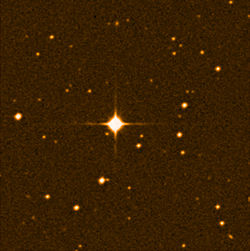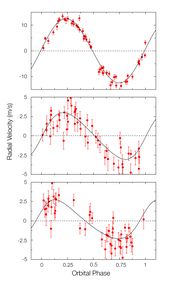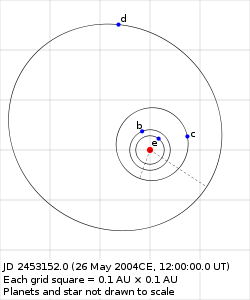Gliese 581
 The star Gliese 581. Digital Sky Survey photo. |
|
| Observation data Epoch J2000.0 Equinox J2000.0 (ICRS) |
|
|---|---|
| Constellation | Libra |
| Right ascension | 15h 19m 26.8250s[1] |
| Declination | −07° 43′ 20.209″[1] |
| Apparent magnitude (V) | 10.56 to 10.58a |
| Characteristics | |
| Spectral type | M3V[2] |
| B−V color index | 1.61[1] |
| Variable type | BYb |
| Astrometry | |
| Radial velocity (Rv) | −9.5 ± 0.5[1] km/s |
| Proper motion (μ) | RA: −1233.51[3] mas/yr Dec.: −94.52[3] mas/yr |
| Parallax (π) | 160.91 ± 2.62[3] mas |
| Distance | 20.3 ± 0.3 ly (6.2 ± 0.1 pc) |
| Absolute magnitude (MV) | 11.6[4] |
| Details | |
| Mass | 0.31[5] M☉ |
| Radius | 0.29[2] R☉ |
| Surface gravity (log g) | 4.92 ± 0.10[6] |
| Luminosity (bolometric) | 0.013[2] L☉ |
| Temperature | 3,480 ± 48[6] K |
| Metallicity | [M/H] = −0.33 ± 0.12[6] |
| Age | 7 to 11 × 109[5][7] years |
| Other designations | |
| Database references | |
| SIMBAD | data |
Gliese 581 (pronounced /ˈɡliːzə/) is a red dwarf star with spectral type M3V, located 20.3 light years away from Earth in the constellation Libra. Its estimated mass is about a third of that of the Sun, and it is the 87th[9] closest known star system to the Sun. Observations suggest that the star has at least four planets: Gliese 581 b, c, d, e.[10]
The star system gained attention after Gliese 581 c, the first low mass extrasolar planet found to be near its star's habitable zone, was discovered in April 2007. It has since been shown that under known terrestrial planet climate models, Gliese 581 c is likely to have a runaway greenhouse effect, and hence is probably not habitable. However, the subsequently discovered outermost planet Gliese 581 d is firmly within the habitable zone. In April 2009, the discovery of exoplanet Gliese 581 e,[10] at that time the closest-known in mass to Earth, was announced.
Contents |
Star
The name Gliese 581 refers to the catalog number from the Gliese Catalogue of Nearby Stars. Other names of this star include BD-07° 4003 (BD catalogue, first known publication) and HO Librae (variable star designation). It does not have an individual name such as Sirius or Procyon.[1][8] The star is a red dwarf with spectral type M3V, located 20.3 light years away from Earth. It is located about two degrees north of Beta Librae, the brightest star in the constellation Libra. Its mass is estimated to be approximately a third that of the Sun, and it is the 87th closest known star system to the Sun.[9]

An M-class dwarf star such as Gliese 581 has a much lower mass than the Sun, causing the core region of the star to burn hydrogen at a significantly lower rate. From the apparent magnitude and distance, we can estimate an effective temperature of 3200 kelvins and a visual luminosity of 0.2% of that of the Sun.[11] However, a red dwarf such as Gliese 581 radiates primarily in the near infrared, with peak emission at a wavelength of roughly 830 nanometres (estimated using Wien's displacement law, which assumes the star radiates as a black body), so such an estimate will underestimate the star's total luminosity.[12] (For comparison, the peak emission of the Sun is roughly 530 nanometres, in the middle of the visible part of the spectrum). When radiation over the entire spectrum is taken into account (not just the part that humans are able to see), something known as the bolometric correction, this star has a bolometric luminosity 1.3% of the Sun's total luminosity.[2][11] A planet would need to be situated much closer to this star in order to receive a comparable amount of energy as the Earth. The region of space around a star where a planet would receive roughly the same energy as the Earth is sometimes termed the "Goldilocks Zone", or, more prosaically, the habitable zone. The extent of such a zone is not fixed and is highly specific for each planetary system.[13] Gliese 581 appears too massive to be a Flare star which makes life more probable.[14] Gliese 581 does emit X-rays.[15]
Planetary system
At least four planets are believed to be orbiting Gliese 581. Gliese 581 b, approximately Neptune-sized, was discovered in August 2005 and was the fifth planet to be discovered around a red dwarf star. This inner planet is at least 16 times as massive as Earth (similar to Neptune's mass) and completes a full orbit of Gliese 581 in only 5.4 days.[2]

Another planet, Gliese 581 c, was discovered in April 2007.[16] In their 2007 paper, Udry et al. assumed that if Gliese 581 c had a Earth-type composition, it would have a radius of 1.5R⊕, which would make it "the most Earth-like of all known exoplanets".[16].
A direct measurement of the radius cannot be taken because, viewed from Earth, the planet does not transit its sun. With a minimum mass of roughly five times Earth—or one third that of Neptune—Gliese 581 c orbits just inside of the habitable zone of its parent star.[17] It is notable as it is the planet with lowest minimum mass yet discovered in the habitable zone of another star, making it the most earthlike exoplanet found to date.[18] The mean blackbody surface temperature has been estimated to lie between -3 °C (for a Venus-like albedo) and 40 °C (for an Earth-like albedo),[16] however, the temperatures could be much higher (about 500 degrees Celsius) due to a runaway greenhouse effect akin to that of Venus.[19] Some astronomers believe the system may have undergone planetary migration and Gliese 581 c may have formed beyond the frost line, with a composition similar to icy bodies like Ganymede. Gliese 581 c completes a full orbit in just under 13 days.[16]

Observations of the star also revealed a third planet, Gliese 581 d, with a mass of roughly 7 Earths, or half a Uranus, and an orbit of 66.8 Earth days.[11][20][21] It orbits just inside of the habitable zone of its star, which makes it a potential candidate for being able to support life.[10][19]
Discovery of a fourth planet, Gliese 581 e, was announced on 21 April 2009. This planet, at an estimated minimum mass of 1.9 Earths, is currently the lowest mass exoplanet identified around a normal star. It takes 3.15 days to orbit Gliese 581.[10][21]
Dynamical simulations of the Gliese 581 system assuming that the orbits of planets b to d are coplanar show that the system becomes unstable if its component masses are more than 1.6 – 2 times the minimum mass. The upper limits on the masses of the planets are found to be 3.1, 30.4, 10.4 and 13.8 Earth masses for planets e, b, c and d respectively.[10]
| Companion (in order from star) |
Mass | Semimajor axis (AU) |
Orbital period (days) |
Eccentricity |
|---|---|---|---|---|
| e | 1.94 – 3.1 M⊕ | 0.03 | 3.14942 ± 0.00045 | 0 |
| b | 15.65 – 30.4 M⊕ | 0.04 | 5.36874 ± 0.00019 | 0 |
| c | 5.36 – 10.4 M⊕ | 0.07 | 12.9292 ± 0.0047 | 0.17 ± 0.07 |
| d | 7.09 – 13.8 M⊕ | 0.22 | 66.80 ± 0.14 | 0.38 ± 0.09 |
A Message From Earth
In October 2008, members of the networking website Bebo beamed A Message From Earth, a high-power transmission at Gliese 581 c, using the RT-70 radio telescope belonging to the National Space Agency of Ukraine. This transmission is due to arrive in the Gliese 581 system's vicinity by the year 2029; the earliest possible arrival for a response, should there be one, would be in 2049.[22]
See also
- Gliese 876
- List of extrasolar planets
Notes
- Note a: Note b: Gl 581 is classified as a BY Draconis variable in the General Catalogue of Variable Stars.[23] This catalog gives a maximum magnitude of 10.56 and minimum of magnitude 10.58 for a relatively low 20 mmag (0.020 magnitudes) variability.[24] For full data see data description and "The combined table of GCVS Vols I-III and NL 67-78 with improved coordinates, General Catalogue of Variable Stars". Sternberg Astronomical Institute. http://www.sai.msu.su/groups/cluster/gcvs/gcvs/iii/iii.dat. In 1994 Edward Weis concluded that Gl 581, like half the 43 dwarf M stars he studied over a multi-year period, showed long term variability (and page 1137, Fig 1 shows Gl 581 had magnitude 10.58 in 1982 and between 10.57 and 10.56 from 1985 to 1990).[25] Bonfils noted in 2005 that "Gl 581 has been classified as a variable star (HO Lib), but its variability (Weis 1994) is only marginally significant. If real it would be on a time scale of several years, with short term variability being at most ∼0.006 mag."[26] Measurements by MOST showed short term variability of about 5 mmag (half a percent) over a period of a few weeks.[27]
References
- ↑ 1.0 1.1 1.2 1.3 1.4 1.5 V* HO Lib -- Variable Star, database entry, SIMBAD. Accessed on line August 21, 2008.
- ↑ 2.0 2.1 2.2 2.3 2.4 Bonfils et al.; Forveille, T.; Delfosse, X.; Udry, S.; Mayor, M.; Perrier, C.; Bouchy, F.; Pepe, F. et al. (2005). "The HARPS search for southern extra-solar planets, VI. A Neptune-mass planet around the nearby M dwarf Gl 581" (PDF). Astronomy and Astrophysics 443: L15–L18. doi:10.1051/0004-6361:200500193. http://www.aanda.org/articles/aa/pdf/2005/45/aahh223.pdf. Retrieved 2009-04-27.
- ↑ 3.0 3.1 3.2 van Leeuwen, F. (2007). "HIP 74995". Hipparcos, the New Reduction. Strasbourg Astronomical Observatory. http://webviz.u-strasbg.fr/viz-bin/VizieR-5?-out.add=.&-source=I/311/hip2&recno=74749. Retrieved 2008-08-16.
- ↑ From apparent magnitude and parallax.
- ↑ 5.0 5.1 "Star: Gl 581". Extrasolar Planets Encyclopaedia. http://exoplanet.eu/star.php?st=Gl+581. Retrieved 2009-04-27. "0.31 Msun ... 8 (−1+3) Gyr"
- ↑ 6.0 6.1 6.2 Bean, J. L.; Benedict, G. F.; Endl, M. (2006). "Metallicities of M Dwarf Planet Hosts from Spectral Synthesis". The Astrophysical Journal 653 (1): L65–L68. doi:10.1086/510527. http://adsabs.harvard.edu/abs/2006ApJ...653L..65B. Retrieved 2007-02-04.
- ↑ Selsis 3.4 page 1382 "lower limit of the age that, considering the associated uncertainties, could be around 7 Gyr", "preliminary estimate", "should not be above 10-11 Gyr"
- ↑ 8.0 8.1 Entry 5594-1093-1, Tycho Catalogue, The Hipparcos and Tycho Catalogues, CDS ID I/239.
- ↑ 9.0 9.1 "The One Hundred Nearest Star Systems". Research Consortium on Nearby Stars. Georgia State University. January 1, 2009. http://www.chara.gsu.edu/~thenry/RECONS/TOP100.posted.htm. Retrieved 2010-06-04.
- ↑ 10.0 10.1 10.2 10.3 10.4 10.5 Mayor et al. (2009). "The HARPS search for southern extra-solar planets,XVIII. An Earth-mass planet in the GJ 581 planetary system". Astronomy and Astrophysics. http://obswww.unige.ch/~udry/Gl581_preprint.pdf.
- ↑ 11.0 11.1 11.2 Udry, S.; Bonfils, X.; Delfosse, X.; Forveille, T.; Mayor, M.; Perrier, C.; Bouchy, F.; Lovis, C.; Pepe, F.; Queloz, D.; Bertaux, J.-L. (2007). "The HARPS search for southern extra-solar planets. XI. Super-Earths (5 and 8 M⊕) in a 3-planet system". Astronomy and Astrophysics 469 (3): L43 – L47. doi:10.1051/0004-6361:20077612. http://cdsads.u-strasbg.fr/cgi-bin/nph-bib_query?2007A%26A...469L..43U&db_key=AST&nosetcookie=1. Retrieved 2008-08-18.
- ↑ "EDP Sciences". EDP Sciences. http://www.edpsciences.org/papers/aa/full/2005/45/aahh223/aahh223.html. Retrieved 2008-10-05.
- ↑ Selsis et al.; Kasting, J. F.; Levrard, B.; Paillet, J.; Ribas, I.; Delfosse, X. (2007). "Habitable planets around the star Gl 581?". Astronomy and Astrophysics 476 (3): 1373–1387. doi:10.1051/0004-6361:20078091. http://cdsads.u-strasbg.fr/cgi-bin/nph-bib_query?2007A%26A...476.1373S&db_key=AST&nosetcookie=1.
- ↑ http://www.universetoday.com/2009/04/21/nearly-earth-sized-planet-watery-world-spotted-near-another-star/
- ↑ Schmitt JHMM, Fleming TA, Giampapa MS (September 1995). "The X-Ray View of the Low-Mass Stars in the Solar Neighborhood". Ap J. 450 (9): 392–400. doi:10.1086/176149. http://articles.adsabs.harvard.edu//full/1995ApJ...450..392S/0000395.000.html.
- ↑ 16.0 16.1 16.2 16.3 Udry et al.; Bonfils, X.; Delfosse, X.; Forveille, T.; Mayor, M.; Perrier, C.; Bouchy, F.; Lovis, C. et al. (2007). "The HARPS search for southern extra-solar planets, XI. Super-Earths (5 and 8 M⊕) in a 3-planet system" (PDF). Astronomy and Astrophysics 469 (3): L43–L47. doi:10.1051/0004-6361:20077612. http://obswww.unige.ch/~udry/udry_preprint.pdf.
- ↑ W. von Bloh, C. Bounama, M. Cuntz, S. Franck (19 February 2008). [0712.3219] Habitability of Super-Earths: Gliese 581c and 581d. Arxiv.org. http://arxiv.org/abs/0712.3219. Retrieved 2008-10-05.
- ↑ Than, Ker (2007). "New Planet Could Harbor Water and Life". Space.com. http://www.space.com/scienceastronomy/070424_hab_exoplanet.html. Retrieved 2007-05-29.
- ↑ 19.0 19.1 von Bloh et al. (2007). The Habitability of Super-Earths in Gliese 581. 476. Astronomy & Astrophysics. pp. 1365–1371. http://www.aanda.org/index.php?option=article&access=bibcode&bibcode=2007A%2526A...476.1365VPDF. Retrieved 2008-07-20.
- ↑ "New 'super-Earth' found in space". BBC News. 25 April 2007. http://news.bbc.co.uk/1/hi/sci/tech/6589157.stm. Retrieved 2008-10-20.
- ↑ 21.0 21.1 Rincon, Paul; Amos, Jonathan (2009-04-21). "Lightest exoplanet is discovered". BBC. http://news.bbc.co.uk/1/hi/sci/tech/8008683.stm. Retrieved 2009-04-21.
- ↑ "Zimbio Pilot - Gliese 581c". Zimbio.com. 2008-10-13. http://www.zimbio.com/pilot?ID=bwaIrlOhfhm&ZURL=/Gliese+581c/news&URL=http%3A%2F%2Fnews.google.com%2Fnews%2Furl%3Fsa%3DT%26ct%3Dus%2F3-0%26fd%3DR%26url%3Dhttp%3A%2F%2Fblogs.discovermagazine.com%2Fdiscoblog%2F2008%2F10%2F13%2Fbritney-pics-beamed-into-space-thus-far-aliens-remain-silent%2F%26cid%3D0%26ei%3DZ58MSeCgKpLmyASDtuz3AQ%26usg%3DAFQjCNFY_rY3wSipj2eD2pMLrI_lbcEWAg. Retrieved 2009-04-23.
- ↑ Lopez-Morales, M.; Morrell, N. I.; Butler, R. P.; Seager, S. (2006). "Limits to Transits of the Neptune-mass planet orbiting Gl 581". Publications of the Astronomical Society of the Pacific 118. http://arxiv.org/abs/astro-ph/0609255. Retrieved 2009-04-23. "V* HO Lib ... BY Draconis". (page 2 of pre-print submitted 9 September 2006)
- ↑ "General Catalogue of Variable Stars Query results". Sternberg Astronomical Institute, Moscow, Russia. Sternberg Astronomical Institute. http://www.sai.msu.su/groups/cluster/gcvs/cgi-bin/search.cgi?search=HO+Lib. Retrieved 2009-04-27.
- ↑ Weis, Edward W. (March 1994). "Long term variability in dwarf M stars". American Astronomical Society 107 (3): 1138. doi:10.1086/116925. http://adsabs.harvard.edu/abs/1994AJ....107.1135W. Retrieved 2009-04-27.
- ↑ Bonfils page L15
- ↑ J. M. Matthews; others (March 2007). "MOST exoplanet system photometry" (PDF). pp. 80. http://nexsci.caltech.edu/workshop/2007/Matthews.pdf. Retrieved 2009-04-27.
External links
Wikinews has related news:
|
- Major Discovery: New Planet Could Harbor Water and Life Space.com
- Gliese 581 / HO Librae Solstation.com
- Extrasolar Planets Encyclopaedia: Gl 581
- Do your own simulation of radio communications to or from Gliese 581
- All Wet? Astronomers Claim Discovery of Earth-like Planet, Scientific American
- Position of Gliese 581 marked on local space (Top right corner)
- Photo of Constellation Libra with Gliese 581
- Artist conceptions of planets of Gliese 581
- Speculation about geology/geochemistry of Gliese 581c The Geochemical Society
- Computer models suggest planetary and extrasolar planet atmospheres - A gas, gas, gas Washington University in St. Louis
- Extrasolar Planet Interactions by Rory Barnes & Richard Greenberg, Lunar and Planetary Lab, University of Arizona
- Earth-like planet found that may support life Ctv.ca
- Gliese 581 - The "Red Dwarf" and implications for its "earthlike" planet Gliese 581c
|
|||||||||||||||||
|
|||||||||||||||||||||||||||||||||||||||||||||||||||||||||||||||||||||||||||||||||||||||||||||||||||||||||||||||||||||||||||||||||||||||||||||||||||||||||||||||||||||||||||||||||||||||||||||||||||||||||||||
|
||||||||||||||||||||||||||||